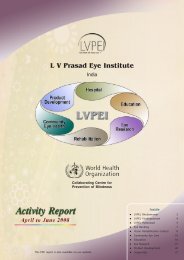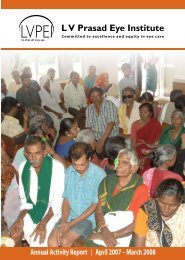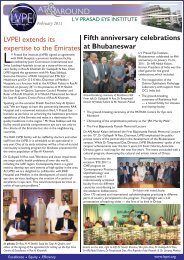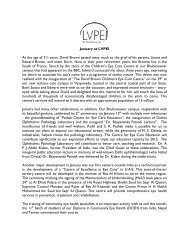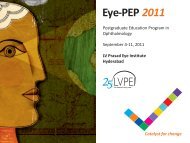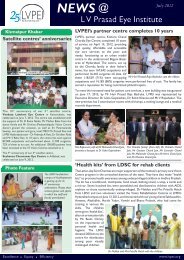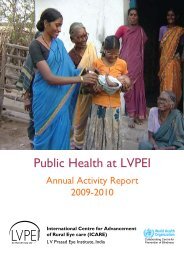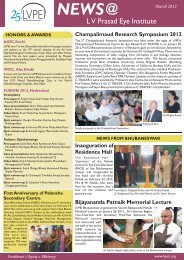IERG Abstracrt Book.indd - LV Prasad Eye Institute
IERG Abstracrt Book.indd - LV Prasad Eye Institute
IERG Abstracrt Book.indd - LV Prasad Eye Institute
You also want an ePaper? Increase the reach of your titles
YUMPU automatically turns print PDFs into web optimized ePapers that Google loves.
Basic Poster Sessions63Results: Arsenic exposure led to damage of eye lens and specifically at 25 ppm concentration,cataract developed. Arsenic exposure at higher concentration (> 25 ppm) altered the lenscrystallin profiles of Labeo rohita. aA-crystallins, which are low molecular weight chaperonswere identified by 1- and 2-D immunoblot analysis; two protein bands of 19 and 20 kDa wereidentified as aA-crystallins on 1D immunoblot and these bands resolved in to 15 discrete spotson 2-D immunoblot. Intensity of few of these protein spots gradually decreased in arsenicexposedfish lens as compared to control.Conclusions: The present study demonstrated that arsenic exposure alters lens aA-crystallinprofile in vivo and induces cataract formation in Labeo rohita.IBP 005Exposure to Homocysteine Negatively Influences Glutathione Synthesis in HumanRetinal Pigment Epithelial (RPE) CellsBharath Selvi , K Coral, K N SulochanaDepartment of Biochemistry and Cell Biology, Vision Research Foundation,Sankara Nethralaya,Chennai, India.Purpose: An increased homocysteine (hcy) level is considered as a risk factor in thepathogenesis of vascular eye diseases. The role of RPE in protecting neural retina from oxidativestress is challenged by hcy. Glutathione (GSH) synthesized from cysteine (cys), a product frommethionine (met) via hcy. In this study, we measured the levels of GSH and the amino acidsinvolved in Met-hcy-cys-GSH axis to understand the effect of hcy on GSH.Methods: Serum starved ARPE-19 cells were exposed to various concentrations of hcyranging 5 µM to 100 µM, for 24 hrs with and without cys of the same concentration rangeand were extracted with 1xPBS. We developed a RP-HPLC method for the analysis of aminoacids following pre-column OPA derivitization, elution by 0.05 M acetate buffer pH 7.0 andflorescence detection. Protein and GSH were determined spectrophotometrically.Results: In increasing concentrations of hcy, the GSH levels were significantly decreased from9 to 4 µg/mg protein. This effect was reversed by the addition of cys. Among the other aminoacids, the increase in taurine and serine was significant with the addition of cys.Conclusions: GSH is mainly produced intracellular in RPE. In this study, we observed that hcynegatively influences GSH synthesis. g-glutamylcysteine ligase (gGCL) is the enzyme responsiblefor the synthesis of GSH and it shares the common pocket for the binding of both hcy and cysbinding. It is possible that hcy is a competitive inhibitor of gGCL and its role in GSH synthesisneeds to be studied further.IBP 006Real Time PCR in the diagnosis of postoperative endophthalmitis.Cornelia Reena Joseph, Lalitha PrajnaDr G Venkataswamy <strong>Eye</strong> Research <strong>Institute</strong>, Aravind Medical Research Foundation,Anna Nagar, Madurai, IndiaPurpose: To assess the utility of Real Time polymerase chain reaction (RT-PCR) in diagnosingpost cataract endophthalmitits and to compare its sensitivity and specificity with those of theconventional microbiologic techniques.



